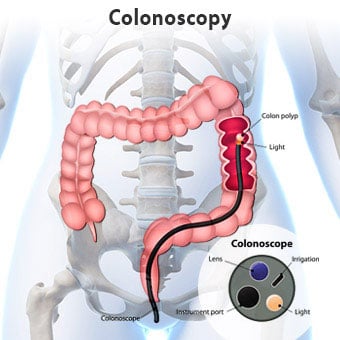A colonoscopy is an important diagnostic procedure that’s usually recommended for everyone by age 50.
A colonoscopy is a procedure that allows a doctor to examine the inside of your colon (part of the large intestine).
A colonoscopy can be done for screening purposes in healthy people, to make sure that they are not developing colon cancer or dangerous polyps that may turn into cancer.
A colonoscopy may also be done to find a diagnosis for bloody stools or other gastrointestinal symptoms, such as pain or changes to bowel habits (diarrhea or constipation).
Who Should Have a Colonoscopy?
Most guidelines suggest that everyone should have a screening colonoscopy by age 50, and then every ten years (if no concerning symptoms develop).
If you have a family history of colon cancer, known polyps, or certain other intestinal conditions, you may need to have a colonoscopy at a younger age or more frequently.
How to Prepare for a Colonoscopy
You'll be given instructions for a special "prep" prior to your colonoscopy:
You may also be asked to follow a specific diet for the day or two before the procedure.
The night before your colonoscopy, you may be given a solution to drink, laxative pills, an enema, and/or a suppository to make sure your intestine is empty.
These preparations will cause diarrhea, so you'll need to stay close to a bathroom after starting the prep.
Be sure that your doctor knows about all of your medications, vitamins, and dietary supplements. Ask if you should discontinue any of them in the days before the procedure.
You will also need to arrange for a ride home post-procedure as colonoscopy requires light sedation.
What Happens During a Colonoscopy?
To begin, you'll be asked to lie on your side on a table and will be given sedation, either with a pill or through an IV.
During the procedure, a trained specialist will insert a colonoscope — a long, flexible, narrow tube with a light and tiny camera on one end — into your rectum and your colon.
The scope also blows air into your large intestine to provide a better view, and the camera on the end of the colonoscope sends a video image to a monitor so your doctor can better view the tissue.
Your doctor will view the entirety of your large intestine and begin to slowly withdraw the colonoscope once he or she has reached your small intestine.
Tissues samples (biopsies) and/or polyp removal can be performed through the scope. These samples may be sent to a laboratory to test for cancer.
Colonoscopy Side Effects
It is normal to feel bloated, gassy, and sleepy after the procedure. There may be a small amount of blood in your first bowel movement.
Symptoms that should prompt an immediate call to your doctor include:
- Fever
- Severe pain
- Passing large amounts of blood or blood clots
- Weakness
- Dizziness
As with all procedures, there are some risks associated with a colonoscopy, including:
- Bleeding
- Colon perforation
- Reaction to the sedative


Editorial Sources and Fact-Checking
- Frequently Asked Questions About Colonoscopy and Sigmoidoscopy (American Cancer Society).
- What is a Colonoscopy? (National Institute of Diabetes and Digestive and Kidney Diseases).











































